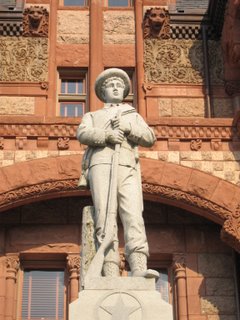The reason one comes to Waxahachie, other than necessity, is to see the courthouse. It's a beautiful building, and would be the center of town if anyone other than antique hunters went to the center of town.
The courthouse has a myth about it, that a German mason named Harry Herley fell in love with Mabel Frame, the daughter of his landlord in town. He began carving her portrait on the building to show his love. In some versions, his love in unrequited; in others, her father prevents them from being together. If you believe the former story, you can walk around the building and see Herley become embittered, and Mabel's face become more and more horrific. It's not true, even if there was a mason named Harry Herley who worked on the building, but it makes a good story, especially for tourists.

In front of the courthouse is a monument to the Confederate soldiers of Ellis County. A child-soldier stands atop it, his hands clutching a rifle. It reads:
In honor of
the dead and living
of Ellis County
who wore the gray.
Banners may be furled
but heroism lives forever.
Erected by the
Daughters of the
Confederacy,
unveiled Nov. 2, 1912
This world view, and the ethos that goes with it, are common in Texas. The Civil War (or, more commonly, the War between the States) wasn't about the "right" to enslave others, but about the nebulous concept of states' rights. And the soldiers weren't fighting on the Confederate side weren't fighting for slavery, but to prove their mettle in battle. The war was a means to an end, then: a means, since heroism lives forever, of earning immortality.
I don't mean to say that the Daughters of the Confederacy, or any similar organization, are out-and-out racists who want slavery revived. In Texas it may be socially acceptable to stridently vocalize reactionary political views, but the idea of "Southern heritage" is something else. If you measure racism by effect, by consequences rather than intent, you could present a strong argument that monuments like Waxahachie's are racist. But the more time you spend around the monuments, the more clear it becomes that any explicit racist intent is absent. Instead, I think, two desires dovetail into the preoccupations with the Confederate flag and "heritage violations" that one finds today.
The first is the romanticism—or romanticization—of the antebellum South. This is both a rosy view of crinolines and crinolettes, wool jacket and frock coats, as well as of the nobility of the aristocracy and the Lost Cause. Things were better then, obviously, and the architecture better, the people more noble.
The idea of the nobler past exists everywhere, for all time, so it's not really surprising here. Hesiod's Works and Days, for example, is basically about how all the men who came before his present day—about 700 BCE—were nobler and better. Homer likewise likes to point out that his heroes toss boulders that would take three modern men just to lift. It's all a myth, and it's all human.
But even more than this, the celebration of the Confederacy is a 140-year study in denial. By celebrating the past and making venerating Confederate soldiers as valorous heroes, the South never has to face the sobering fact that the Confederacy was an ignoble cause. Make the soldiers into heroes and you don't have to admit that your side, your boys, were wrong. Make the soldiers into heroes and you don't have to face an ancestry of villains. Make the solders into heroes and you don't have to question your own righteousness.
The South1 has taken a completely different course from, say, postwar Germany. Where Germany looked inward after the war, saw the root cause of their suffering and saw it was themselves, the South looked outward and saw only blue uniforms, only the proximate cause. You still hear the word carpetbagger today, even in Texas, and at the Sam's Food Mart in Waxahachie I got a $5 bill with Lincoln's face punched out.
But it's that righteousness that gets me, the certitude. It's the same righteousness that makes me uneasy among evangelists, from Hare Krishnas to Pentecostals to atheists. It's a righteousness that is unwilling not to listen to others, but to see life from another position, another station. To perhaps hundreds of thousands of others, the Confederate battle flag is a symbol of pride; to millions of others, it is a symbol of slavery, hatred, oppression. How do you think it is a symbol of rebellion except in the strictest, most literal sense? How can you wear it, in diamonds, on your finger?
To the Confederate States: Your suffering was all your own.
1 And yes, I include Texas in the South, no matter what it thinks of itself.




No comments:
Post a Comment